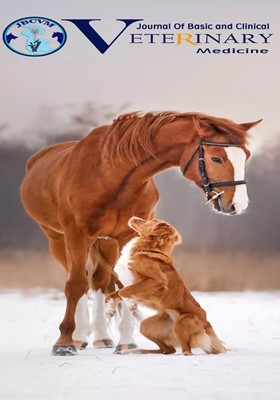Occurrence of progressive and corrosive lesions in perineal area of a Kurd stallion due to oxyuris equi
Subject Areas : ParasitologySeyed AbdolHamid Hoseini 1 , Saeid Mostofi 2 , mohammad Tolouei 3 *
1 - Department of clinical sciences, Faculty of Veterinary Medicine, University of Tabriz, Tabriz, Iran
2 - Laboratory staff, Veterinary Office of East Azerbaijan Province, Tabriz, Iran
3 - Department of clinical sciences, Faculty of veterinary medicine, University of Tabriz, Tabriz, Iran
Keywords: horse, Oxyuris equi, parasitic infestation, corrosive wound,
Abstract :
Parasitic infestation is one of the most common problem in horses breeding worldwide as in Iran. Oxyuris equi belongs to Nematodes and involves gastrointestinal tract and perineal region of equines. In this study, occurrence of an unusual form of Oxyuriasis in an adult horse in Iran, Tabriz is reported. In autumn of 2018 a Kurd stallion with symptoms of itching and some deep and corrosive lesions in perineal region and around anus was examined at one of equestrian clubs of Tabriz province. Vital signs of animal were normal. The wounds had spread around perineum, above the extremities and even below the tail, a big corrosive and progressive lesion had developed. After collecting feces samples and parasitological test, eggs and even larvae of Oxyuris equi were observed. According to the clinical and parasitological examinations, involvement of Oxyuriasis was considered. Treatment of the disease started with anti-parasitic drugs such as pyrantel, oxybendazole and ivermectin, although the lesions were disinfected with iodide solution, vitamin A+D ointment and Tetracycline. The lesions were recovered over than 90%, about 20 days after treatment. As in the report, oxyuriasis can be seen unusual form as corrosive and progressive lesions in perineal region in even adult horses.
[1] VJ_Volume 11_Issue 1_Pages 130-131.pdf.
[2] Bucknell D, Hoste H, Gasser RB, Beveridge I. The structure of the community of strongyloid nematodes of domestic equids. 1996;185–92.
[3] Lichtenfels JR, Kharchenko VA, Dvojnos GM. Illustrated identification keys to strongylid parasites (strongylidae: Nematoda) of horses, zebras and asses (Equidae). Vet Parasitol. 2008;156(1–2):4–161.
[4] Saeed MA, Beveridge I, Abbas G, Beasley A, Bauquier J, Wilkes E, et al. Systematic review of gastrointestinal nematodes of horses from Australia. Parasites and Vectors . 2019;12(1):1–16.
[5] Reinemeyer CR, Nielsen MK. Review of the biology and control of Oxyuris equi. Equine Vet Educ. 2014; 26(11):584–91.
[6] Wolf D, Hermosilla C, Taubert A. Oxyuris equi: Lack of efficacy in treatment with macrocyclic lactones. Vet Parasitol. 2014;201(1–2):163–8.
[7] Coles GC, Jackson F, Pomroy WE, Prichard RK, Von Samson-Himmelstjerna G, Silvestre A, et al. The detection of anthelmintic resistance in nematodes of veterinary importance. Vet Parasitol. 2006;136(3–4):167–85.
[8] Menzies-gow AN. Pinworm – a growing irritation. 2014;1–7.
[9] Debra S. Equine infectious diseases (Sellon). 2nd Edition. Debra C. Sellon MTL, editor. St. Louis, Missouri: Copyright © 2014, 2007 by Saunders, an imprint of Elsevier Inc.; 2014. 445–455 p.
[10] Reinemeyer CR. Anthelmintic resistance in non-strongylid parasites of horses. Vet Parasitol. 2012;185(1):9–15.
[11] Reinemeyer CR, Prado JC, Nichols EC, Marchiondo AA. Efficacy of pyrantel pamoate and ivermectin paste formulations against naturally acquired Oxyuris equi infections in horses. Vet Parasitol. 2010;171(1–2):106–10.
[12] Nielsen MK, Reinemeyer CR, Sellon DC. Nematodes. Second Edi. Equine Infectious Diseases: Second Edition. Elsevier Inc.; 2013. 475-489.e4 p.
[13] Wilkes EJA, Cowling A, Woodgate RG, Hughes KJ. Inhomogeneity of the density of Parascaris spp. eggs in faeces of individual foals and the use of hypothesis testing for treatment decision making. Vet Parasitol. 2016;229:131–8.
[14] Lyons ET, Tolliver SC, Kuzmina TA, Collins SS. Critical tests evaluating efficacy of moxidectin against small strongyles in horses from a herd for which reduced activity had been found in field tests in Central Kentucky. Parasitol Res. 2010;107(6):1495–8.
[15] Cleale RM, Edmonds JD, Paul AJ, Reinemeyer CR, Chapman MR, Clem R, et al. A multicenter evaluation of the effectiveness of Quest® Gel (2% moxidectin) against parasites infecting equids. Vet Parasitol. 2006;137(1–2):119–29.
[16] Durham A, Coles G. Worm control in horses: Possible resistance in equine pinworms. Vet Rec. 2010;167(23):913–4.
[17] Stephenson R. Oxyuris equi a resurgent problem? Companion Anim. 2010; 15(5): 8–10.
[18] Bauer C, Çirak VY, Hermosilla C, Okoro H. Efficacy of a 2 per cent moxidectin gel against gastrointestinal parasites of ponies. Vet Rec. 1998;143(20):558–61.

